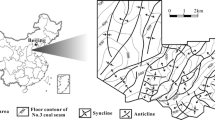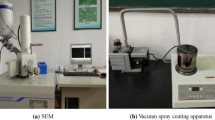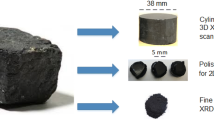Abstract
The technology of liquid carbon dioxide phase change fracturing (LCPCF) was used to enhance the permeability of coal seams. The combination of mechanical tests, scanning electron microscopy (SEM) and high-pressure mercury intrusion porosimetry was adopted to study the damage characteristics of coal micro-structures. LCPCF had mechanical damage effects on coal micro-structures to varying degrees, and the maximum reduction in compressive strength reached approximately 25%. SEM results confirmed that surface morphology of coal was remarkably altered after conducting LCPCF. The fractal dimension (D) of coal subjected to LCPCF ranged from 1.5186 to 1.8794, demonstrating the three-stage changing trends. HP-MIP results showed that LCPCF mainly affected pores of > 100 nm within coal, and pores < 100 nm were hardly influenced. When 1.26 L of liquid CO2 was used to conduct physical blasting, at distance of < 1.5 m, the influence of LCPCF was strengthened. Affected by the high-energy gas and shock wave generated by LCPCF, meso-pores within coal were damaged and shifted to the larger pores, resulting in the increase in the number of macro-pores and micro-fractures. When distance was > 1.5 m, the obvious reduction in macro-pore and micro-fracture volumes implied that the fracturing effect was attenuated with the increase in distance. Once distance was > 6.0 m, pore and fracture structures within coal tended to be stable. Thus, in this study, the influence scope of LCPCF was around 6.0 m for a single fracturing borehole.










Similar content being viewed by others
References
Al-Ameri, A., Gamadi, T., & Ispas, I. (2018). Evaluation of the near fracture face formation damage caused by the spontaneously imbibed fracturing fluid in unconventional gas reservoirs. Journal of Petroleum Science and Engineering, 171, 23–36.
Ao, X., Lu, Y. Y., Tang, J. R., Chen, Y. T., & Li, H. L. (2017). Investigation on the physics structure and chemical properties of the shale treated by supercritical CO2. Journal of CO2 Utilization, 20, 274–281.
Behera, S. K., Meena, H., Chakraborty, S., & Meikap, B. C. (2018). Application of response surface methodology (RSM) for optimization of leaching parameters for ash reduction from low-grade coal. International Journal of Mining Science and Technology, 28(4), 621–629.
Busch, A., Gensterblum, Y., & Krooss, B. M. (2007). High-pressure sorption of nitrogen, carbon dioxide, and their mixtures on argonne premium coals. Energy & Fuels, 21(3), 1640–1645.
Cavelan, A., Boussafir, M., Rozenbaum, O., & Laggoun-Defarge, F. (2019). Organic petrography and pore structure characterization of low-mature and gas-mature marine organic-rich mudstones: Insights into porosity controls in gas shale systems. Marine and Petroleum Geology, 103, 331–350.
Chen, H. D., Wang, Z. F., Chen, X. E., Chen, X. J., & Wang, L. G. (2017). Increasing permeability of coal seams using the phase energy of liquid carbon dioxide. Journal of CO2 Utilization, 19, 112–119.
Dendisova, M., Jeništová, A., Parchaňská-Kokaislová, A., Matejka, P., Prokopec, V., & Svecova, M. (2018). The use of infrared spectroscopic techniques to characterize nanomaterials and nanostructures: A review. Analytica Chimica Acta, 1031, 1–14.
Gao, F., Tang, L. H., Zhou, K. P., Zhang, Y. A., & Ke, B. (2018). Mechanism analysis of liquid carbon dioxide phase transition for fracturing rock masses. Energies, 11(11), 2909.
Grau, J., Méndez, V., Tarquis, A. M., Díaz, M. C., & Saa, A. (2006). Comparison of gliding box and box-counting methods in soil image analysis. Geoderma, 134(3–4), 349–359.
Harpalani, S., & Mitra, A. (2010). Impact of CO2 injection on flow behavior of coalbed methane reservoirs. Transport in Porous Media, 82(1), 141–156.
He, X. Q., Liu, X. F., Nie, B. S., & Song, D. Z. (2017). FTIR and Raman spectroscopy characterization of functional groups in various rank coals. Fuel, 206, 555–563.
He, X. Q., Liu, X. F., Song, D. Z., & Nie, B. S. (2019). Effect of microstructure on electrical property of coal surface. Applied Surface Science, 483, 713–720.
Hol, S., Spiers, C. J., & Peach, C. J. (2012). Microfracturing of coal due to interaction with CO2 under unconfined conditions. Fuel, 97, 569–584.
Hu, G. Z., He, W. R., & Sun, M. (2018). Enhancing coal seam gas using liquid CO2 phase-transition blasting with cross-measure borehole. Journal of Natural Gas Science and Engineering, 60, 164–173.
Hu, S. B., Wang, E. Y., & Liu, X. F. (2016). Effective stress of gas-bearing coal and its dual pore damage constitutive model. International Journal of Damage Mechanics, 25(4), 468–490.
Ju, W., Jiang, B., Qin, Y., Wu, C. F., Wang, G., Qu, Z. H., & Li, M. (2019). The present-day in-situ stress field within coalbed methane reservoirs, Yuwang Block, Laochang Basin, south China. Marine and Petroleum Geology, 102, 61–73.
Katz, B. J., & Arango, I. (2018). Organic porosity: A geochemist’s view of the current state of understanding. Organic Geochemistry, 123, 1–16.
Kiani, A., Sakurovs, R., Grigore, M., Keshavarz, A., & White, S. (2019). The use of infrared spectroscopy to determine methane emission rates from coals at atmospheric pressures. Energy & Fuels, 33(1), 238–247.
Kong, X. G., Wang, E. Y., Li, S. G., Lin, H. F., Xiao, P., & Zhang, K. Z. (2019). Fractals and chaos characteristics of acoustic emission energy about gas-bearing coal during loaded failure. Fractals, 27(5), 1950072.
Kong, X. G., Wang, E. Y., Li, S. G., Lin, H. F., Zhang, Z. B., & Ju, Y. Q. (2020). Dynamic mechanical characteristics and fracture mechanism of gas-bearing coal based on SHPB experiments. Theoretical and Applied Fracture Mechanics, 105, 102395.
Li, H. S., Liu, S. Y., Jia, J. G., Wang, F. C., & Guo, C. W. (2020). Numerical simulation of rock-breaking under the impact load of self-excited oscillating pulsed waterjet. Tunnelling and Underground Space Technology, 96, 103179.
Li, H., Shi, S. L., Lin, B. Q., Lu, J. X., Lu, Y., Ye, Q., et al. (2019). A fully coupled electromagnetic, heat transfer and multiphase porous media model for microwave heating of coal. Fuel Processing Technology, 189, 49–61.
Li, H., Shi, S. L., Lu, J. X., Ye, Q., Li, Y., & Zhu, X. N. (2019). Pore structure and multifractal analysis of coal subjected to microwave heating. Powder Technology, 346, 97–108.
Li, X. L., Li, Z. H., Wang, E. Y., Liang, Y. P., Li, B. L., Chen, P., & Liu, Y. J. (2018). Pattern recognition of mine microseismic and blasting events based on wave fractal features. Fractals, 26(3), 1850029.
Liu, C., Shi, B., Zhou, J., & Tang, C. S. (2011). Quantification and characterization of microporosity by image processing, geometric measurement and statistical methods: Application on SEM images of clay materials. Applied Clay Science, 54, 97–106.
Liu, S., Cui, Y. M., Chen, Y. Q., & Guo, C. W. (2019). Numerical research on rock breaking by abrasive water jet-pick under confining pressure. International Journal of Rock Mechanics and Mining Sciences, 120, 41–49.
Liu, S. M., Li, X. L., Wang, D. K., Wu, M. Y., Yin, G. Z., & Li, M. H. (2020). Mechanical and acoustic emission characteristics of coal at temperature impact. Natural Resources Research, 9(3), 1755–1772.
Liu, X. F., & Nie, B. S. (2016). Fractal characteristics of coal samples utilizing image analysis and gas adsorption. Fuel, 182, 314–322.
Liu, X., Nie, B. S., Wang, W. X., Wang, Z. P., & Zhang, L. (2019). The use of AFM in quantitative analysis of pore characteristics in coal and coal-bearing shale. Marine and Petroleum Geology, 105, 331–337.
Liu, X. F., Song, D. Z., He, X. Q., Nie, B. S., & Wang, L. K. (2019). Insight into the macromolecular structural differences between hard coal and deformed soft coal. Fuel, 245, 188–197.
Liu, X. F., Song, D. Z., He, X. Q., Wang, Z. P., Zeng, M. R., & Deng, K. (2019a). Nanopore structure of deep-burial coals explored by AFM. Fuel, 246, 9–17.
Liu, X. F., Song, D. Z., He, X. Q., Wang, Z. P., Zeng, M. R., & Wang, L. K. (2019b). Quantitative analysis of coal nanopore characteristics using atomic force microscopy. Powder Technology, 346, 332–340.
Liu, X. F., Wang, Z. P., Song, D. Z., He, X. Q., & Yang, T. (2020). Variations in surface fractal characteristics of coal subjected to liquid CO2 phase change fracturing. International Journal of Energy Research, 44(11), 8740–8753.
Loucks, R. G., Reed, R. M., Ruppel, S. C., & Jarvie, D. M. (2009). Morphology, genesis, and distribution of nanometer-scale pores in siliceous mudstones of the Mississippian Barnett Shale. Journal of Sedimentary Research, 79, 848–861.
Lu, Y. Y., Ao, X., Tang, J. R., Jia, Y. Z., Zhang, X. W., & Chen, Y. T. (2016). Swelling of shale in supercritical carbon dioxide. Journal of Natural Gas Science and Engineering, 30, 268–275.
Ma, J. L., Li, Q., Kühn, M., & Nakaten, N. (2018). Power-to-gas based subsurface energy storage. A review. Renewable and Sustainable Energy Reviews, 97, 478–496.
Mastalerz, M., Schimmelmann, A., Drobniak, A., & Chen, Y. Y. (2013). Porosity of Devonian and Mississippian New Albany Shale across a maturation gradient: Insights from organic petrology, gas adsorption, and mercury intrusion. AAPG Bulletin, 97(10), 1621–1643.
Medina, C. R., Mastalerz, M., & Rupp, J. A. (2018). Pore system characterization of Cambrian-Ordovician carbonates using a new mercury porosimetry-based petrofacies classification system: Application to carbon sequestration reservoirs. Greenhouse Gases: Science and Technology, 8(5), 932–953.
Mortazavi, A., & Atapour, H. (2018). An experimental study of stress changes induced by reservoir depletion under true triaxial stress loading conditions. Journal of Petroleum Science and Engineering, 171, 1366–1377.
Nie, B. S., Liu, X. F., Yang, L. L., Meng, J. Q., & Li, X. C. (2015). Pore structure characterization of different rank coals using gas adsorption and scanning electron microscopy. Fuel, 158, 908–917.
Pan, Y., Hui, D., Luo, P. Y., Zhang, Y., Zhang, L., & Sun, L. (2018). Influences of subcritical and supercritical CO2 treatment on the pore structure characteristics of marine and terrestrial shales. Journal of CO2 Utilization, 28, 152–167.
Pandey, R., & Harpalani, S. (2018). An imaging and fractal approach towards understanding reservoir scale changes in coal due to bioconversion. Fuel, 230, 282–297.
Panesar, D. K., & Francis, J. (2014). Influence of limestone and slag on the pore structure of cement paste based on mercury intrusion porosimetry and water vapour sorption measurements. Construction and Building Materials, 52, 52–58.
Perera, M. S. A. (2017). Influences of CO2 injection into deep coal seams: A review. Energy & Fuels, 31(10), 10324–10334.
Ranathunga, A. S., Perera, M. S. A., Ranjith, P. G., Zhang, X. G., & Wu, B. (2017). Super-critical carbon dioxide flow behaviour in low rank coal: A meso-scale experimental study. Journal of CO2 Utilization, 20, 1–13.
Sakurovs, R., He, L., Melnichenko, Y. B., Radlinski, A. P., Blach, T., Lemmel, H., & Mildner, D. F. R. (2012). Pore size distribution and accessible pore size distribution in bituminous coals. International Journal of Coal Geology, 100, 51–64.
Sampath, K. H. S. M., Perera, M. S. A., Ranjith, P. G., Matthai, S. K., & Li, D. Y. (2019). Qualitative and quantitative evaluation of the alteration of micro-fracture characteristics of supercritical CO2-interacted coal. The Journal of Supercritical Fluids, 147, 90–101.
Sazali, Y. A., Sazali, W. M. L., Ibrahim, J. M., Dindi, M., Graham, G., & Godeke, S. (2019). Investigation of high temperature, high pressure, scaling and dissolution effects for carbon capture and storage at a high CO2 content carbonate gas field offshore Malaysia. Journal of Petroleum Science and Engineering, 174, 599–606.
Service, R. F. (2016). Cost of carbon capture drops, but does anyone want it? Science, 354(6318), 1362–1363.
Singh, S. P. (1998). Non-explosive applications of the PCF concept for underground excavation. Tunneling and Underground Space Technology, 13, 305–311.
Tan, P., Pang, H. W., Zhang, R. X., Jin, Y., Zhou, Y. C., Kao, J. W., & Fan, M. (2020). Experimental investigation into hydraulic fracture geometry and proppant migration characteristics for southeastern Sichuan deep shale reservoirs. Journal of Petroleum Science and Engineering, 184, 106517.
Tripathy, A., Srinivasan, V., & Singh, T. N. (2018). A comparative study on the pore size distribution of different Indian shale gas reservoirs for gas production and potential CO2 sequestration. Energy & Fuels, 32(3), 3322–3334.
Vidanovic, N., Ognjanovic, S., Ilincic, N., Ilic, N., & Tokalic, R. (2011). Application of unconventional methods of underground premises construction in coal mines. Technics Technologies Education Management, 6, 861–865.
Vishal, V. (2017). In-situ disposal of CO2: Liquid and supercritical CO2 permeability in coal at multiple down-hole stress conditions. Journal of CO2 Utilization, 17, 235–242.
Wang, Q. Q., Zhang, D. F., Wang, H. H., Jiang, W. P., Wu, X. P., Yang, J., & Huo, P. L. (2015). Influence of CO2 exposure on high-pressure methane and CO2 adsorption on various rank coals: Implications for CO2 sequestration in coal seams. Energy & Fuels, 29(6), 3785–3795.
Wei, Q., Li, X. Q., Zhang, J. Z., Zhu, W. W., Lian, W. L., & Sun, K. X. (2019). Full-size pore structure characterization of deep-buried coals and its impact on methane adsorption capacity: A case study of the Shihezi Formation coals from the Panji Deep Area in Huainan Coalfield, Southern North China. Journal of Petroleum Science and Engineering, 173, 975–989.
White, C. M., Smith, D. H., Jones, K. L., Goodman, A. L., Jikich, S. A., LaCount, R. B., et al. (2005). Sequestration of carbon dioxide in coal with enhanced coalbed methane recovery: A review. Energy & Fuels, 19(3), 659–724.
Wilson, M. P., Worrall, F., Davies, R. J., & Almond, S. (2018). Fracking: How far from faults? Geomechanics and Geophysics for Geo-Energy and Geo-Resources, 4(2), 193–199.
Xu, J. K., Zhou, R., Song, D. Z., Li, N., Zhang, K., & Xi, D. Y. (2019). Deformation and damage dynamic characteristics of coal–rock materials in deep coal mines. International Journal of Damage Mechanics, 28(1), 58–78.
Yang, W. D., Li, G. Z., Ranjith, P. G., & Fang, L. D. (2019). An experimental study of mechanical behavior of brittle rock-like specimens with multi-non-persistent joints under uniaxial compression and damage analysis. International Journal of Damage Mechanics, 28(10), 1580–1604.
Yang, X. L., Wen, G. C., Sun, H. T., Li, X. L., Lu, T. K., Dai, L. C., et al. (2019). Environmentally friendly techniques for high gas content thick coal seam stimulation—multi-discharge CO2 fracturing system. Journal of Natural Gas Science and Engineering, 61, 71–82.
Yılmaz, O., Bleyer, J., & Molinari, J. F. (2018). Influence of heterogeneities on crack propagation. International Journal of Fracture, 209(1–2), 77–90.
Yin, T. T., Liu, D. M., Cai, Y. D., Zhou, Y. F., & Yao, Y. B. (2017). Size distribution and fractal characteristics of coal pores through nuclear magnetic resonance cryoporometry. Energy & Fuels, 31(8), 7746–7757.
Yu, K., Ju, Y. W., Qi, Y., Qiao, P., Huang, C., Zhu, H. J., & Feng, H. Y. (2019). Fractal characteristics and heterogeneity of the nanopore structure of marine shale in Southern North China. Minerals, 9(4), 242.
Yu, K., Ju, Y. W., Qian, J., Qu, Z. H., Shao, C. J., Yu, K. L., & Shi, Y. (2018). Burial and thermal evolution of coal-bearing strata and its mechanisms in the southern North China Basin since the late Paleozoic. International Journal of Coal Geology, 198, 100–115.
Yue, J. W., Wang, Z. F., Chen, J. S., Zheng, M. H., Wang, Q., & Lou, X. F. (2019). Investigation of pore structure characteristics and adsorption characteristics of coals with different destruction types. Adsorption Science & Technology, 37(7–8), 623–648.
Zhang, X. G., Gamage, R. P., Perera, M. S. A., Haque, A., & Ranathunga, A. S. (2019). The influence of CO2 saturation time on the coal gas flow: Fractured bituminous coal. Fuel, 240, 153–161.
Zhang, X. G., Ranjith, P. G., Li, D. Y., Perera, M. S. A., Ranathunga, A. S., & Zhang, B. N. (2018). CO2 enhanced flow characteristics of naturally-fractured bituminous coals with N2 injection at different reservoir depths. Journal of CO2 Utilization, 28, 393–402.
Zhang, Y. H., Lebedev, M., Sarmadivaleh, M., Barifcani, A., & Iglauer, S. (2016). Swelling-induced changes in coal microstructure due to supercritical CO2 injection. Geophysical Research Letters, 43, 9077–9083.
Zhou, S. D., Liu, D. M., Cai, Y. D., Yao, Y. B., Che, Y., & Liu, Z. H. (2017). Multi-scale fractal characterizations of lignite, subbituminous and high-volatile bituminous coals pores by mercury intrusion porosimetry. Journal of Natural Gas Science and Engineering, 44, 338–350.
Zhu, H. J., Ju, Y. W., Huang, C., Han, K., Qi, Y., Shi, M. Y., et al. (2019). Pore structure variations across structural deformation of Silurian Longmaxi Shale: An example from the Chuandong Thrust-Fold Belt. Fuel, 241, 914–932.
Zhu, H. J., Ju, Y. W., Qi, Y., Huang, C., & Zhang, L. (2018). Impact of tectonism on pore type and pore structure evolution in organic-rich shale: Implications for gas storage and migration pathways in naturally deformed rocks. Fuel, 228, 272–289.
Acknowledgments
This study was financially supported by the National Natural Science Foundation of China (Grant Nos. 52004042, 51974127, U19B2009) and the State Key Laboratory Cultivation Base for Gas Geology and Gas Control (Henan Polytechnic University) (Grant No. WS2019B08).
Author information
Authors and Affiliations
Corresponding author
Rights and permissions
About this article
Cite this article
Liao, Z., Liu, X., Song, D. et al. Micro-structural Damage to Coal Induced by Liquid CO2 Phase Change Fracturing. Nat Resour Res 30, 1613–1627 (2021). https://doi.org/10.1007/s11053-020-09782-5
Received:
Accepted:
Published:
Issue Date:
DOI: https://doi.org/10.1007/s11053-020-09782-5




